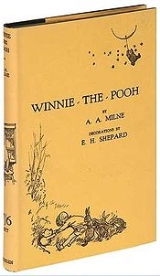
Winnie the Pooh in the Hundred Acre Wood
Encyclopedia
Winnie the Pooh in the Hundred Acre Wood was a single player adventure game created by Sierra On-Line
. It is based on the character Winnie the Pooh.
Sierra Entertainment
Sierra Entertainment Inc. was an American video-game developer and publisher founded in 1979 as On-Line Systems by Ken and Roberta Williams...
. It is based on the character Winnie the Pooh.
Plot
The Hundred Acre Wood was populated with characters from A.A. Milne's Winnie the Pooh series of short stories. Each character had lost an item of value to them and wanted the item returned. Whoever was playing the game moved through the Hundred Acre Wood and collected the missing items and returned them to their rightful owner. Only one item could be carried at a time, so picking up one item necessitated the leaving behind of whatever item was currently being carried. Some screens had interactive sub elements. For example: you could "climb" Pooh's tree and see the limb where he kept his honey pots safely out of the reach of flood waters (a reference to a scene in the Disney animated movie "The Many Adventures of Winnie the Pooh"and Chapter 9 of A.A. Milne's book Winnie-the-Pooh.). The game had no animation in the mode of a traditional Quest game such as Space Quest or King's Quest. Rather, the Hundred Acre Wood existed as a grid of connected static screens. Players moved between the screen using the arrow keys and could only move North, South, East or West. The missing items were randomly assigned at the start of each new game to screens within this grid, although the various characters could always be found on the same screens. When an item was "dropped" on a screen in order to "pick up" another item, the dropped item stayed on that screen until the user returned to retrieve it later. Reuniting a character with their item resulted in a celebration screen.External links
- http://www.if-legends.org/~adventure/Sierra_On-Line,_Inc.html
- http://www.allowe.com/More/download.htm

